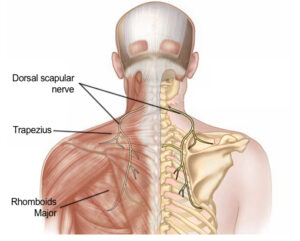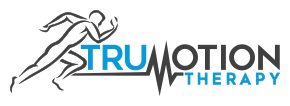April 26th, 2022
Identifying Deep Knots in Shoulder Blades Symptoms
If you have ever experienced a tender spot on the inside edge of your shoulder blade, you know how annoying that shoulder blade knot can be. Rubbing it against the corner of a wall or smashing it with a lacrosse ball never does the trick.¬† What if I were to tell you that ‚Äúknot‚ÄĚ you feel isn‚Äôt a knot at all? Keep reading to identify deep knots in shoulder blade symptoms.

Pain in that area is ‚Äúreferred pain‚ÄĚ from the neck the majority of the time.¬† The source of the issue is in one spot and the pain is felt in another.¬† This can explain why digging into the painful spot provides temporary relief at best.¬†¬†
The joints of the neck can send pain to several places including down the arm, into the hand, and especially to that pesky area around your shoulder blade.  There is a nerve called the dorsal scapular nerve that is often responsible for this issue as it starts in the neck and ends right by the shoulder blade.  

The Role of Postural Strain in Neck and Shoulder Blade Knot Discomfort
Shoulder blade knots typically arise from prolonged postural strain (sitting at a computer for too long) or, less frequently, from an acute strain (forcefully lifting weights).  The strain on the neck, whether from chronic postural strain or an acute strain, can cause the joints and nerves to become sensitive.  Since the neck is like the circuit breaker to the body, an issue there can cause pain downstream.  
If you notice a light is out in your house you should first check to see if it’s a problem with the lightbulb.  When replacing the lightbulb doesn’t do the trick you should check your breaker box.  If you see a breaker has been flipped, you know the problem is in one area, but the symptoms of the problem are in another.  
To address this shoulder blade knot pain, we need to address the source of the issue.  Make sure your desk is set up ergonomically (see the video below).  
Ergonomic Tips to Prevent Shoulder Blade Knot Pain
When you are sitting at your desk with your hands on your keyboard your elbows should be resting at 90 degrees.  Making height adjustments to your chair and desk can help accomplish this.  Your screen should be at eye level, and be sure to bring your keyboard in close so you are not overreaching.  Setting your desk up properly is barely half the battle.  Taking small movement breaks throughout the day is key for overall spine and muscle health.  Try not to sit for more than 45 minutes without getting up and moving to help eliminate shoulder blade knot pain.
Effective Movements and Stretches for Should Blade Knot Pain Relief
Movements like the one in the video below are often used to reduce joint strain in the neck.  This is called a cervical retraction, and it helps decompress the joints in the neck.  You should not experience pain with this movement.  If this or other movements of the neck are painful, it is important to see a qualified spine care practitioner. 
Additional Stretches to Alleviate Pain
Other stretches like the corner stretch shown below address some of the muscles that get tight when we sit for extended periods. The muscle in question here is the pectoralis major.  When it gets tight it will pull the shoulders forward.  When the shoulders are pulled forward tension is put on the muscles and nerves in the back of the shoulders and upper back.  
When to Seek Professional Help for Persistent Neck and Shoulder Blade Knot Pain
Regarding neck and shoulder blade knot pain, it is best to see a medical professional before attempting to fix it yourself.  The above article is for informational purposes only and not meant to diagnose or treat and health conditions.  Every case of neck, shoulder, and back pain is different and requires a unique approach.  These issues are often resolved quickly without medication or invasive procedures if treatment begins shortly after the onset of symptoms.  
If you’re experiencing pain in or around your neck or shoulder, we’re here to help.  Click HERE to schedule an appointment at our Charlotte office to find shoulder blade knot pain relief. 





